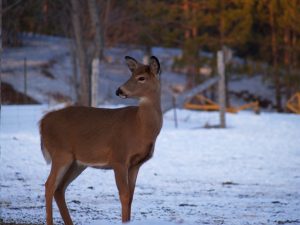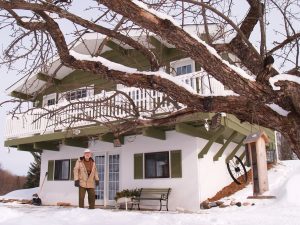
In 1970 Joe and Edith bought 100 acres in the Hartsmere area near McArthurs Mills in eastern Ontario. The Lott family homestead had fallen into disrepair and so Joe tore it down. He and Edith then built a chalet into the hillside styled after the Austrian design. They paid $5000. “We never could have afforded this in Austria. That would be an entire farm there.”
One of the first projects was to feed the deer. In the early 70’s there was no abundance of deer as we know there are today. Cold harsh winters took their toll on the deer populations. At work, in his travels, Joe would come across people who were going to throw salt out because the bag had a hole in it, for example. Joe would take the salt to the chalet on the weekend and dump it out near a tree. The following weekend he would notice that it had disappeared and he would be so excited, “just like a kid”, to see deer tracks in the snow. So encouraged, Joe continued to feed the deer. As in Austria, Joe started to identify the various animals. A dream kindled in childhood was about to be realized. In Austria it couldn’t have happened. The cost would have been prohibitive. In Canada it could and would come true.

In January 2000, 70 elk from Elk Island National Park, Alberta, were re-introduced to the North Hastings area, east of the town of Bancroft. Similarly, elk were being re-introduced east of Highway #71 near Sioux Narrows in NorthWest Ontario; north of the Iron Bridge, east of Sault Ste. Marie and west of Highway #69 and southwest of Sudbury. Since the early days when they escaped, with some human assistance, from the Burwash Correctional Farm, elk have survived in the French River area.